Internationalization: Marketing Analysis for Australian Agriculture
VerifiedAdded on 2023/06/01
|6
|1254
|403
Report
AI Summary
This report provides a marketing analysis for an Australian agricultural company seeking internationalization, employing the PESTEL framework to evaluate political, economic, social, technological, environmental, and legal factors influencing market entry. It critically weighs adaptation and standardization considerations using the EPRG schema, examining ethnocentric, polycentric, regiocentric, and geocentric orientations. The analysis further evaluates market-driven versus market-driving strategies, highlighting the importance of innovation and customer value. The report contrasts sales-driven, market-driven, and customer-driven approaches, emphasizing the need for a responsive global strategy tailored to local requirements. Desklib offers this and other solved assignments to aid students in their studies.
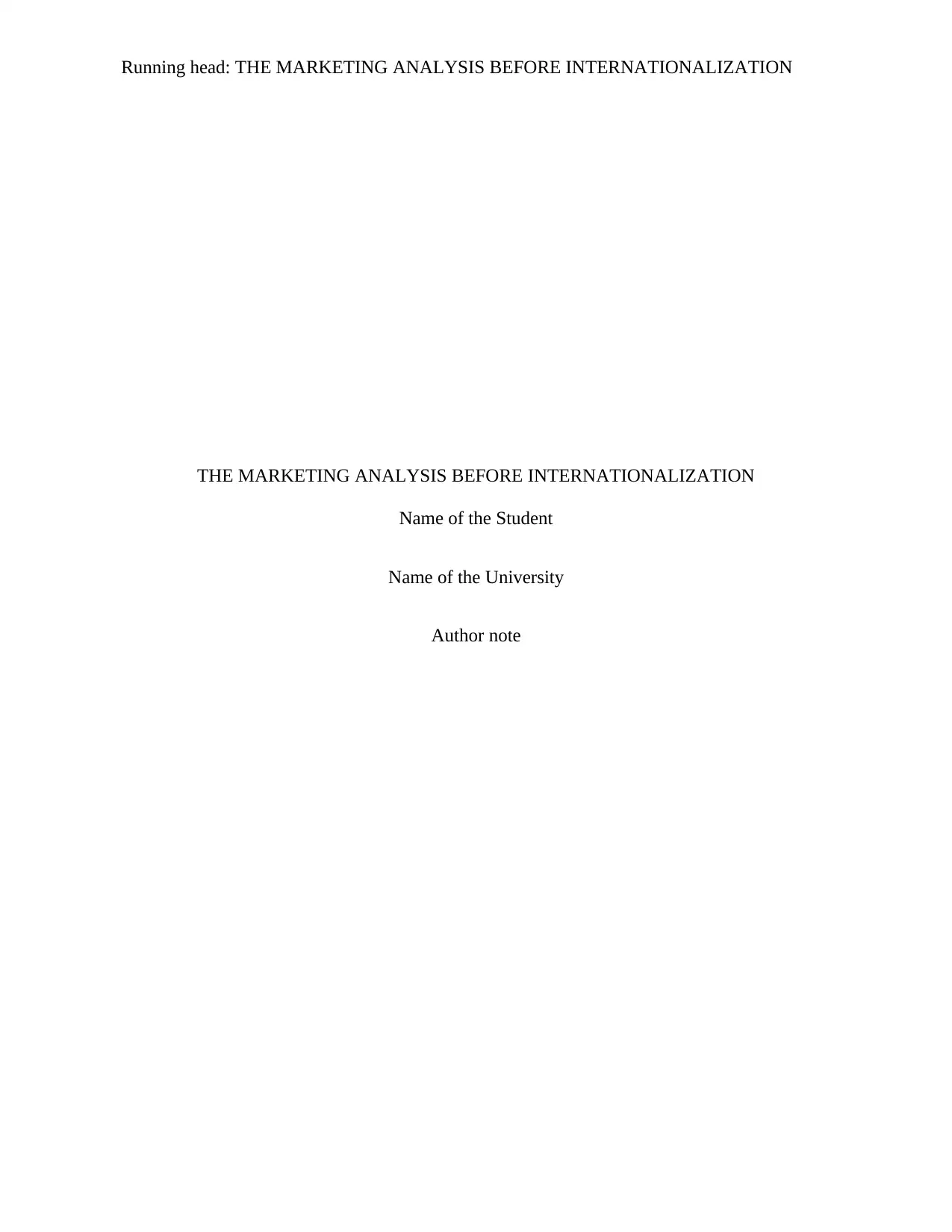
Running head: THE MARKETING ANALYSIS BEFORE INTERNATIONALIZATION
THE MARKETING ANALYSIS BEFORE INTERNATIONALIZATION
Name of the Student
Name of the University
Author note
THE MARKETING ANALYSIS BEFORE INTERNATIONALIZATION
Name of the Student
Name of the University
Author note
Paraphrase This Document
Need a fresh take? Get an instant paraphrase of this document with our AI Paraphraser
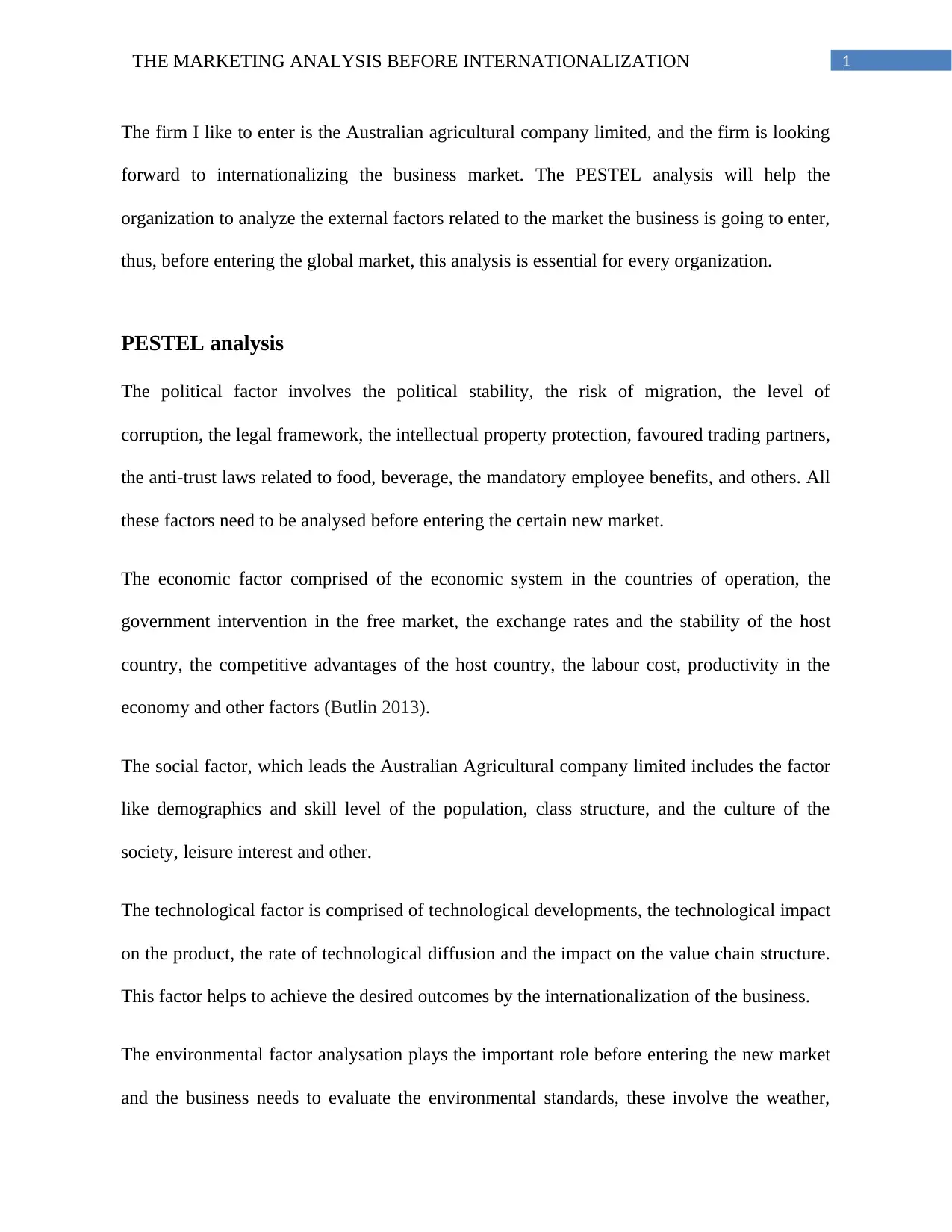
1THE MARKETING ANALYSIS BEFORE INTERNATIONALIZATION
The firm I like to enter is the Australian agricultural company limited, and the firm is looking
forward to internationalizing the business market. The PESTEL analysis will help the
organization to analyze the external factors related to the market the business is going to enter,
thus, before entering the global market, this analysis is essential for every organization.
PESTEL analysis
The political factor involves the political stability, the risk of migration, the level of
corruption, the legal framework, the intellectual property protection, favoured trading partners,
the anti-trust laws related to food, beverage, the mandatory employee benefits, and others. All
these factors need to be analysed before entering the certain new market.
The economic factor comprised of the economic system in the countries of operation, the
government intervention in the free market, the exchange rates and the stability of the host
country, the competitive advantages of the host country, the labour cost, productivity in the
economy and other factors (Butlin 2013).
The social factor, which leads the Australian Agricultural company limited includes the factor
like demographics and skill level of the population, class structure, and the culture of the
society, leisure interest and other.
The technological factor is comprised of technological developments, the technological impact
on the product, the rate of technological diffusion and the impact on the value chain structure.
This factor helps to achieve the desired outcomes by the internationalization of the business.
The environmental factor analysation plays the important role before entering the new market
and the business needs to evaluate the environmental standards, these involve the weather,
The firm I like to enter is the Australian agricultural company limited, and the firm is looking
forward to internationalizing the business market. The PESTEL analysis will help the
organization to analyze the external factors related to the market the business is going to enter,
thus, before entering the global market, this analysis is essential for every organization.
PESTEL analysis
The political factor involves the political stability, the risk of migration, the level of
corruption, the legal framework, the intellectual property protection, favoured trading partners,
the anti-trust laws related to food, beverage, the mandatory employee benefits, and others. All
these factors need to be analysed before entering the certain new market.
The economic factor comprised of the economic system in the countries of operation, the
government intervention in the free market, the exchange rates and the stability of the host
country, the competitive advantages of the host country, the labour cost, productivity in the
economy and other factors (Butlin 2013).
The social factor, which leads the Australian Agricultural company limited includes the factor
like demographics and skill level of the population, class structure, and the culture of the
society, leisure interest and other.
The technological factor is comprised of technological developments, the technological impact
on the product, the rate of technological diffusion and the impact on the value chain structure.
This factor helps to achieve the desired outcomes by the internationalization of the business.
The environmental factor analysation plays the important role before entering the new market
and the business needs to evaluate the environmental standards, these involve the weather,
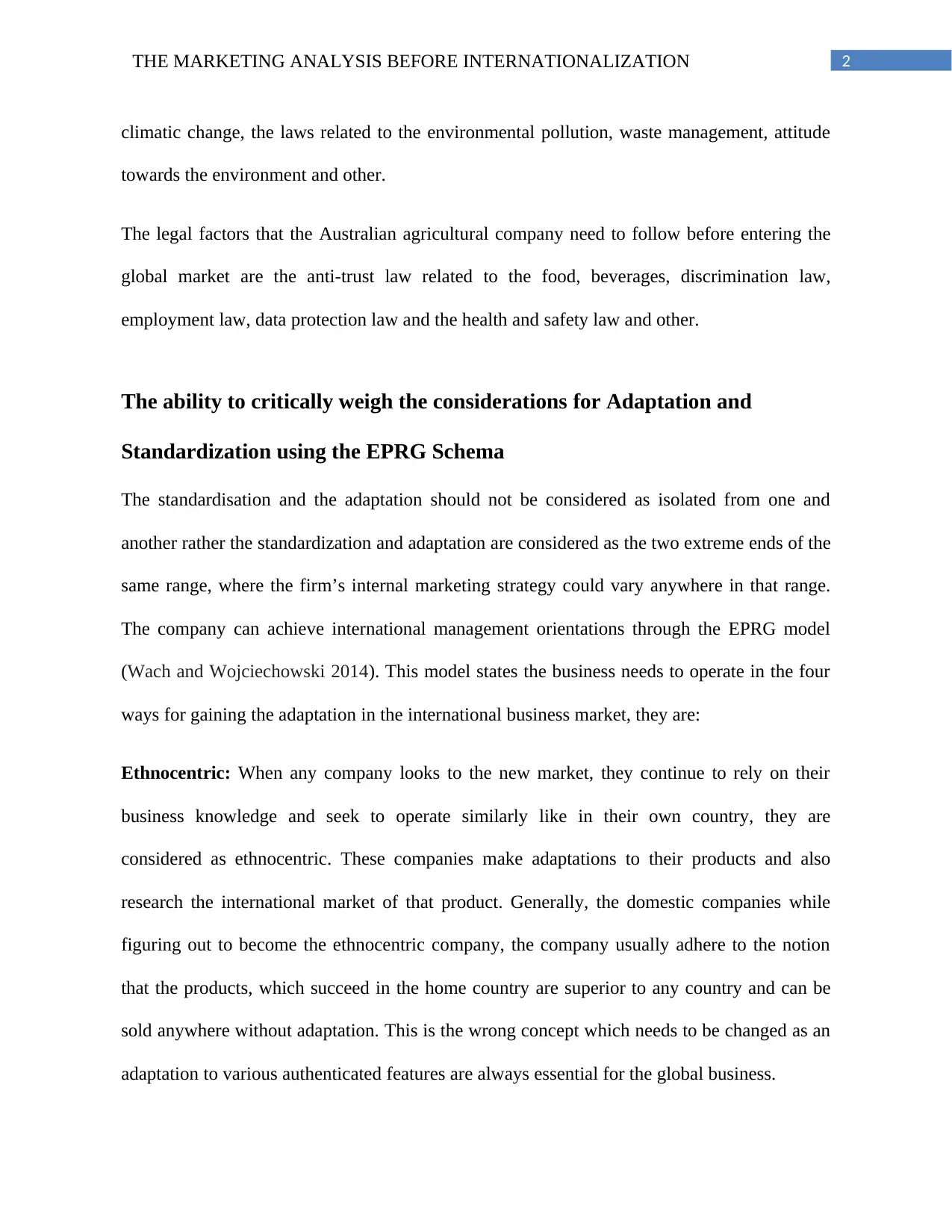
2THE MARKETING ANALYSIS BEFORE INTERNATIONALIZATION
climatic change, the laws related to the environmental pollution, waste management, attitude
towards the environment and other.
The legal factors that the Australian agricultural company need to follow before entering the
global market are the anti-trust law related to the food, beverages, discrimination law,
employment law, data protection law and the health and safety law and other.
The ability to critically weigh the considerations for Adaptation and
Standardization using the EPRG Schema
The standardisation and the adaptation should not be considered as isolated from one and
another rather the standardization and adaptation are considered as the two extreme ends of the
same range, where the firm’s internal marketing strategy could vary anywhere in that range.
The company can achieve international management orientations through the EPRG model
(Wach and Wojciechowski 2014). This model states the business needs to operate in the four
ways for gaining the adaptation in the international business market, they are:
Ethnocentric: When any company looks to the new market, they continue to rely on their
business knowledge and seek to operate similarly like in their own country, they are
considered as ethnocentric. These companies make adaptations to their products and also
research the international market of that product. Generally, the domestic companies while
figuring out to become the ethnocentric company, the company usually adhere to the notion
that the products, which succeed in the home country are superior to any country and can be
sold anywhere without adaptation. This is the wrong concept which needs to be changed as an
adaptation to various authenticated features are always essential for the global business.
climatic change, the laws related to the environmental pollution, waste management, attitude
towards the environment and other.
The legal factors that the Australian agricultural company need to follow before entering the
global market are the anti-trust law related to the food, beverages, discrimination law,
employment law, data protection law and the health and safety law and other.
The ability to critically weigh the considerations for Adaptation and
Standardization using the EPRG Schema
The standardisation and the adaptation should not be considered as isolated from one and
another rather the standardization and adaptation are considered as the two extreme ends of the
same range, where the firm’s internal marketing strategy could vary anywhere in that range.
The company can achieve international management orientations through the EPRG model
(Wach and Wojciechowski 2014). This model states the business needs to operate in the four
ways for gaining the adaptation in the international business market, they are:
Ethnocentric: When any company looks to the new market, they continue to rely on their
business knowledge and seek to operate similarly like in their own country, they are
considered as ethnocentric. These companies make adaptations to their products and also
research the international market of that product. Generally, the domestic companies while
figuring out to become the ethnocentric company, the company usually adhere to the notion
that the products, which succeed in the home country are superior to any country and can be
sold anywhere without adaptation. This is the wrong concept which needs to be changed as an
adaptation to various authenticated features are always essential for the global business.
⊘ This is a preview!⊘
Do you want full access?
Subscribe today to unlock all pages.

Trusted by 1+ million students worldwide
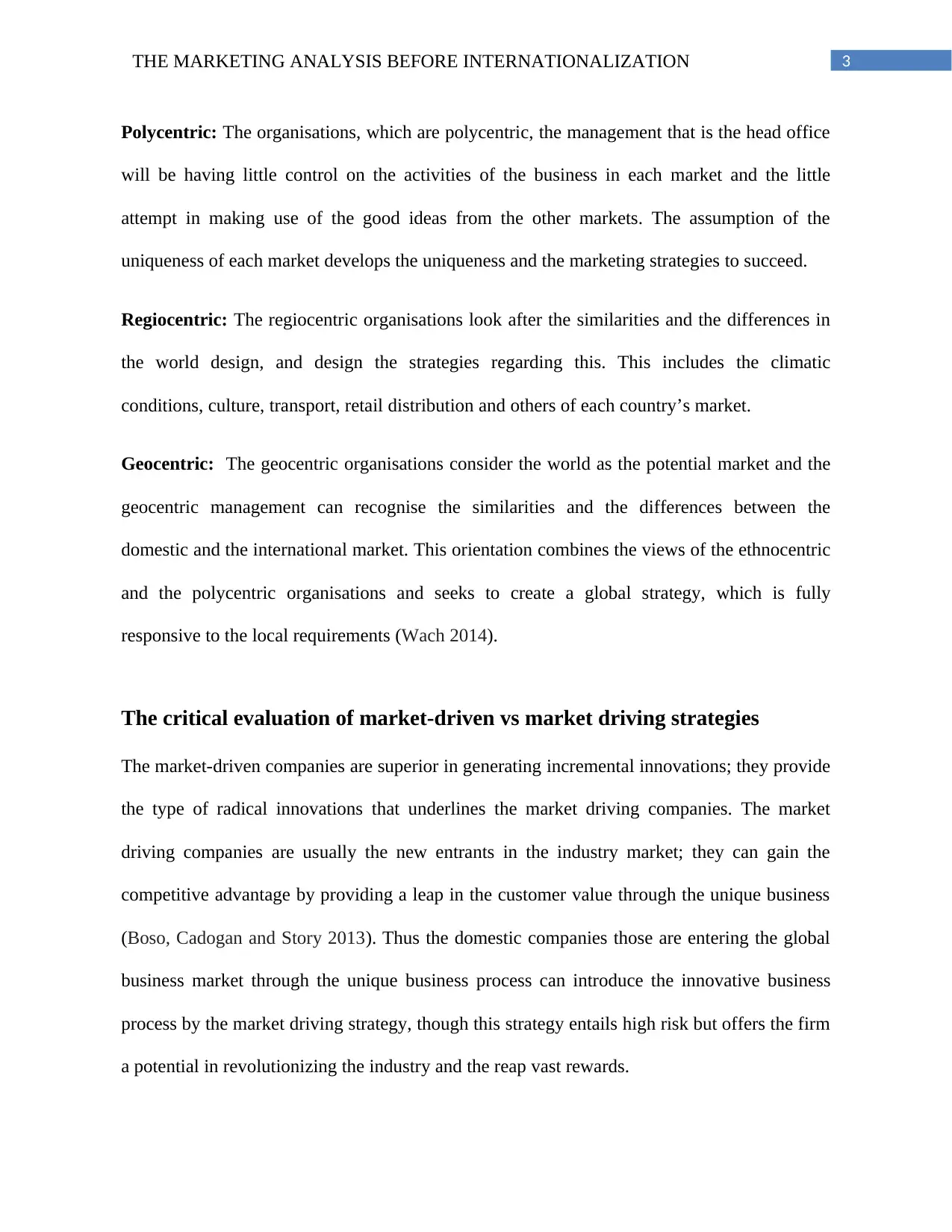
3THE MARKETING ANALYSIS BEFORE INTERNATIONALIZATION
Polycentric: The organisations, which are polycentric, the management that is the head office
will be having little control on the activities of the business in each market and the little
attempt in making use of the good ideas from the other markets. The assumption of the
uniqueness of each market develops the uniqueness and the marketing strategies to succeed.
Regiocentric: The regiocentric organisations look after the similarities and the differences in
the world design, and design the strategies regarding this. This includes the climatic
conditions, culture, transport, retail distribution and others of each country’s market.
Geocentric: The geocentric organisations consider the world as the potential market and the
geocentric management can recognise the similarities and the differences between the
domestic and the international market. This orientation combines the views of the ethnocentric
and the polycentric organisations and seeks to create a global strategy, which is fully
responsive to the local requirements (Wach 2014).
The critical evaluation of market-driven vs market driving strategies
The market-driven companies are superior in generating incremental innovations; they provide
the type of radical innovations that underlines the market driving companies. The market
driving companies are usually the new entrants in the industry market; they can gain the
competitive advantage by providing a leap in the customer value through the unique business
(Boso, Cadogan and Story 2013). Thus the domestic companies those are entering the global
business market through the unique business process can introduce the innovative business
process by the market driving strategy, though this strategy entails high risk but offers the firm
a potential in revolutionizing the industry and the reap vast rewards.
Polycentric: The organisations, which are polycentric, the management that is the head office
will be having little control on the activities of the business in each market and the little
attempt in making use of the good ideas from the other markets. The assumption of the
uniqueness of each market develops the uniqueness and the marketing strategies to succeed.
Regiocentric: The regiocentric organisations look after the similarities and the differences in
the world design, and design the strategies regarding this. This includes the climatic
conditions, culture, transport, retail distribution and others of each country’s market.
Geocentric: The geocentric organisations consider the world as the potential market and the
geocentric management can recognise the similarities and the differences between the
domestic and the international market. This orientation combines the views of the ethnocentric
and the polycentric organisations and seeks to create a global strategy, which is fully
responsive to the local requirements (Wach 2014).
The critical evaluation of market-driven vs market driving strategies
The market-driven companies are superior in generating incremental innovations; they provide
the type of radical innovations that underlines the market driving companies. The market
driving companies are usually the new entrants in the industry market; they can gain the
competitive advantage by providing a leap in the customer value through the unique business
(Boso, Cadogan and Story 2013). Thus the domestic companies those are entering the global
business market through the unique business process can introduce the innovative business
process by the market driving strategy, though this strategy entails high risk but offers the firm
a potential in revolutionizing the industry and the reap vast rewards.
Paraphrase This Document
Need a fresh take? Get an instant paraphrase of this document with our AI Paraphraser
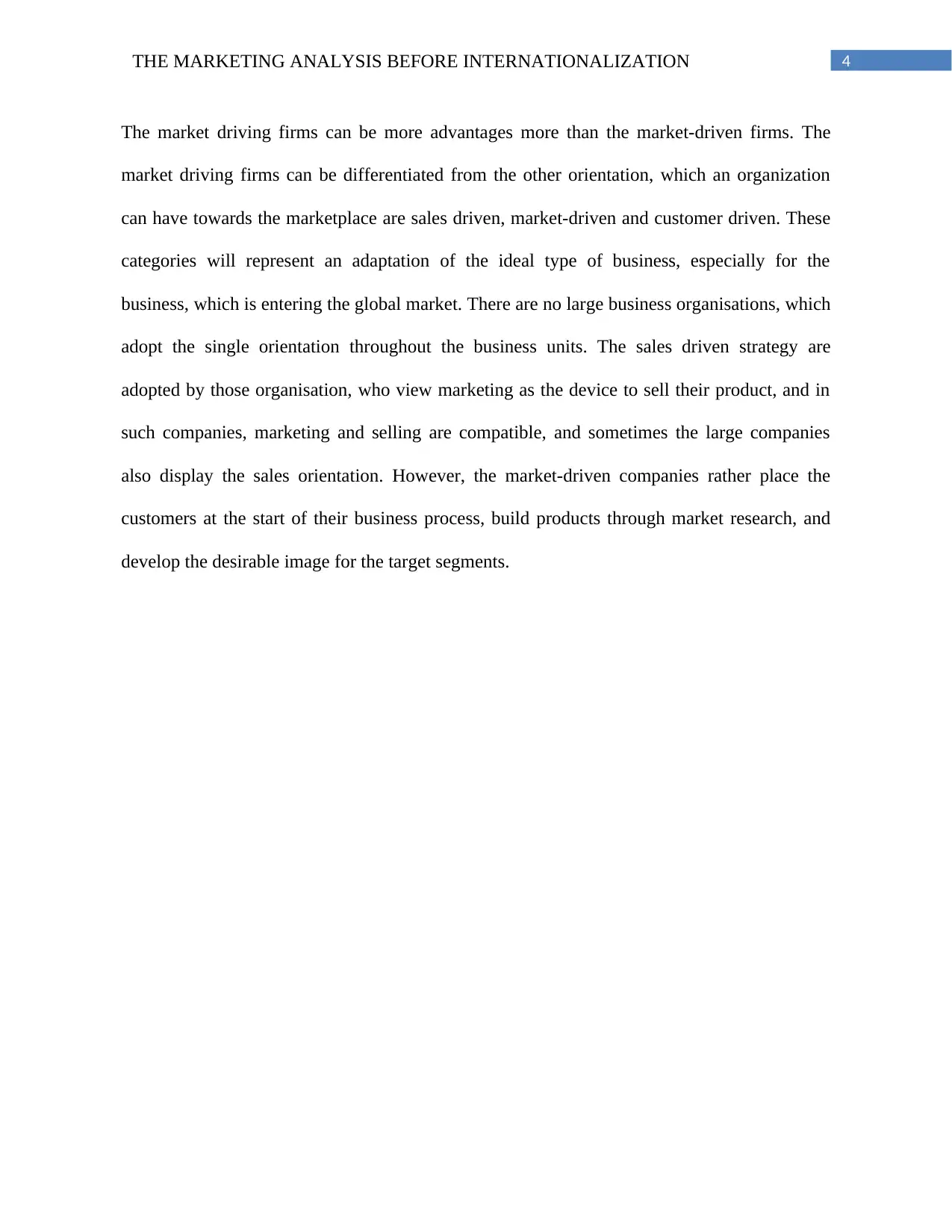
4THE MARKETING ANALYSIS BEFORE INTERNATIONALIZATION
The market driving firms can be more advantages more than the market-driven firms. The
market driving firms can be differentiated from the other orientation, which an organization
can have towards the marketplace are sales driven, market-driven and customer driven. These
categories will represent an adaptation of the ideal type of business, especially for the
business, which is entering the global market. There are no large business organisations, which
adopt the single orientation throughout the business units. The sales driven strategy are
adopted by those organisation, who view marketing as the device to sell their product, and in
such companies, marketing and selling are compatible, and sometimes the large companies
also display the sales orientation. However, the market-driven companies rather place the
customers at the start of their business process, build products through market research, and
develop the desirable image for the target segments.
The market driving firms can be more advantages more than the market-driven firms. The
market driving firms can be differentiated from the other orientation, which an organization
can have towards the marketplace are sales driven, market-driven and customer driven. These
categories will represent an adaptation of the ideal type of business, especially for the
business, which is entering the global market. There are no large business organisations, which
adopt the single orientation throughout the business units. The sales driven strategy are
adopted by those organisation, who view marketing as the device to sell their product, and in
such companies, marketing and selling are compatible, and sometimes the large companies
also display the sales orientation. However, the market-driven companies rather place the
customers at the start of their business process, build products through market research, and
develop the desirable image for the target segments.
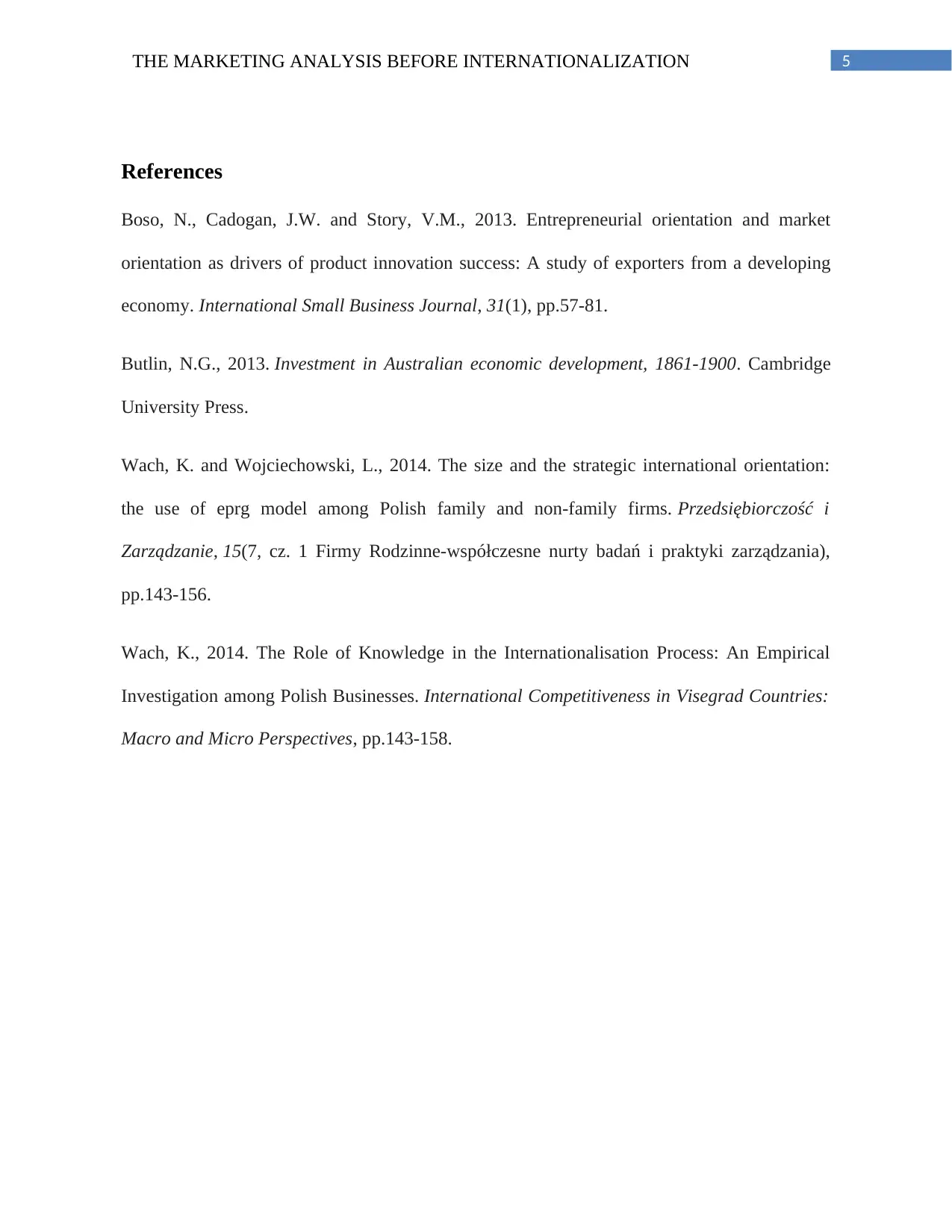
5THE MARKETING ANALYSIS BEFORE INTERNATIONALIZATION
References
Boso, N., Cadogan, J.W. and Story, V.M., 2013. Entrepreneurial orientation and market
orientation as drivers of product innovation success: A study of exporters from a developing
economy. International Small Business Journal, 31(1), pp.57-81.
Butlin, N.G., 2013. Investment in Australian economic development, 1861-1900. Cambridge
University Press.
Wach, K. and Wojciechowski, L., 2014. The size and the strategic international orientation:
the use of eprg model among Polish family and non-family firms. Przedsiębiorczość i
Zarządzanie, 15(7, cz. 1 Firmy Rodzinne-współczesne nurty badań i praktyki zarządzania),
pp.143-156.
Wach, K., 2014. The Role of Knowledge in the Internationalisation Process: An Empirical
Investigation among Polish Businesses. International Competitiveness in Visegrad Countries:
Macro and Micro Perspectives, pp.143-158.
References
Boso, N., Cadogan, J.W. and Story, V.M., 2013. Entrepreneurial orientation and market
orientation as drivers of product innovation success: A study of exporters from a developing
economy. International Small Business Journal, 31(1), pp.57-81.
Butlin, N.G., 2013. Investment in Australian economic development, 1861-1900. Cambridge
University Press.
Wach, K. and Wojciechowski, L., 2014. The size and the strategic international orientation:
the use of eprg model among Polish family and non-family firms. Przedsiębiorczość i
Zarządzanie, 15(7, cz. 1 Firmy Rodzinne-współczesne nurty badań i praktyki zarządzania),
pp.143-156.
Wach, K., 2014. The Role of Knowledge in the Internationalisation Process: An Empirical
Investigation among Polish Businesses. International Competitiveness in Visegrad Countries:
Macro and Micro Perspectives, pp.143-158.
⊘ This is a preview!⊘
Do you want full access?
Subscribe today to unlock all pages.

Trusted by 1+ million students worldwide
1 out of 6
Related Documents
Your All-in-One AI-Powered Toolkit for Academic Success.
+13062052269
info@desklib.com
Available 24*7 on WhatsApp / Email
![[object Object]](/_next/static/media/star-bottom.7253800d.svg)
Unlock your academic potential
Copyright © 2020–2025 A2Z Services. All Rights Reserved. Developed and managed by ZUCOL.




